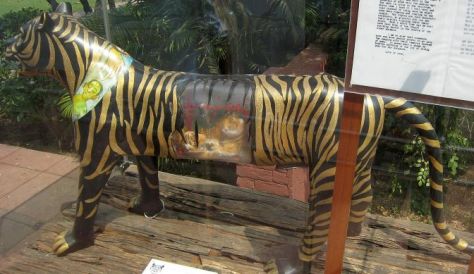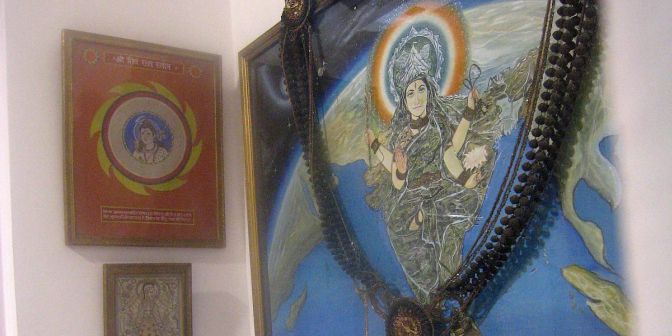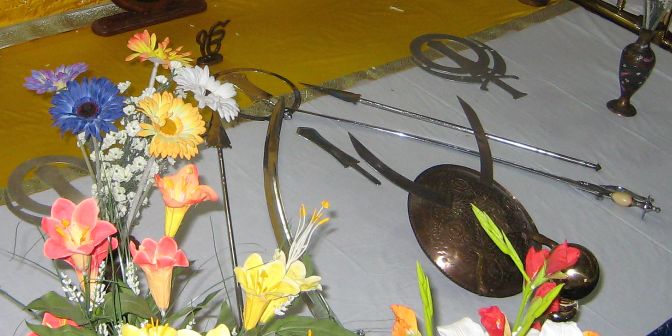I visit gurdwaras and a Prime Minister’s shrine, compare Joan of Arc to black widows and find a hollow tiger.
I’ve entered two golden-domed Sikh gurudwaras in Delhi, one adjacent to my hotel (see my 2007 introduction to Sikhism here). After removing shoes, washing hands and stepping through a shallow pool to rinse my feet, the matter of head coverings arose. In one temple my sunhat was deemed satisfactory; in the other I was lent a headscarf. In both I found a spot under a fan to sit on the carpet and observe. Chanting of scriptures was accompanied by drums and accordion. Worshippers circled the room while a priest fanned their sacred book.
Sikhs are known for distributing free food, and I saw a huge production line making bread: dough ripped into sections, rolled into balls, thrown to the far end of a long trestle for rolling out. As in nursery stories of witches’ cauldrons, the simmering pots of curry and dhal could have boiled up several children with ease.
Unlike the Jains and Mahatma Gandhi who disavow all violence (see previous post), Sikhs are famed for their military prowess – they still form much of India’s army and police – and believe it’s right to wield arms in defence of their faith. After reliving Mahatma Gandhi’s final days I moved to the house of Prime Minister Indira Gandhi (no relation), who ran aground on this faith.
I was surprised to find her memorial house far more crowded than Gandhi’s. Busloads of Indian tourists were filing through the whitewashed bungalow, where security guards even banned water bottles. It was like a pilgrimage temple, kept much as it was when she died. Through glass walls you could see floor to ceiling bookcases, old leather armchairs, framed photos on side tables, and presents from around the world, like a Chinese dragon rug on the floor and an African mask on the wall.
 I saw the same Royal Doulton Bunnykins china plates and bowls that I had as a child, and hundreds of photos, including Indira as a six-year-old girl with Gandhi, who knew the family well. Her father Jawaharlal Nehru was frequently arrested during the independence struggle and he once telegrammed: GOING TO OTHER HOME. I enjoyed this account from Indira’s aunt of their bookish upbringing, with its fateful premonition:
I saw the same Royal Doulton Bunnykins china plates and bowls that I had as a child, and hundreds of photos, including Indira as a six-year-old girl with Gandhi, who knew the family well. Her father Jawaharlal Nehru was frequently arrested during the independence struggle and he once telegrammed: GOING TO OTHER HOME. I enjoyed this account from Indira’s aunt of their bookish upbringing, with its fateful premonition:
Perhaps the love of books all of us had and the well-stocked library at Anand Bhawan [their house in Allahabad] was as good a school as any. From prison Jawaharlal would periodically order a number of books for Indira and she would read fairy tales, children’s editions of Shakespeare, Dickens, Shaw and many classics… Indira had her favourites. She was fascinated by stories about Joan of Arc… One day I saw her standing at the balustrade of the veranda with outstretched arms – she said, “I’m practising being Joan of Arc. I have been reading about her, and someday I’m going to lead my people to freedom just as Joan of Arc did.”
It seems Indira was devout like Joan of Arc. In her Puja Room or prayer closet was a Virgin Mary with a halo of stars, a slim Thai Buddha, a vessel of Ganges water, a chain of prayer beads, and incense sticks in front of statuettes of Hindu gods. On the shelf was a Bible, Koran, Hindu and Sikh Scriptures, and cassettes of devotional music. Indira liked to light an oil lamp before the garlanded Mother India.
Her publicity machine portrayed her like Mother India herself, proclaiming “India is Indira and Indira is India”. Many foreign accolades that she received were on display: the Dutch Order of the Golden Ark, the Lenin Prize, the Dag Hammarskjold award. Countless newspaper clippings documented her great achievements, but I saw no mention of the Emergency rule she declared in 1975 – after being found guilty of electoral malpractice. Joan of Arc may have led her people to freedom, but Indira threw thousands of opposition politicians into prison and gagged the free media (cutting off electricity to independent printing presses), while her son bulldozed slums and force-sterilised the poor. All this led novelist Salman Rushdie to call her the “Black Widow” in his novel Midnight’s Children. In her study was a photo of poet Rabindrath Tagore alongside a famous verse from his Nobel prize-winning Gitanjali (which I introduced here). It echoed the noble Joan of Arc and after the Emergency seemed most ironic:
Where the mind is without fear and the head is held high
Where knowledge is free
Where the world has not been broken up into fragments
By narrow domestic walls…
Into that heaven of freedom, my Father, let my country awake.
Maybe my view has been overly shaped by westernised liberals like Rushdie, because Indira was clearly respected here and the Emergency did have some positive effects. Many socks were quickly pulled up. Power cuts, strikes and inflation were curbed. Trains ran on time and government workers actually came to work – there were not enough desks and chairs in many offices when all staff showed up. It’s joked that queues were last spotted at a Delhi bus stop in February 1977, just before the Emergency ended.
Just as for Gandhi (see previous post) I followed Indira’s final steps outside. Glass covers the footpath up to the spot where, as a sign said, she “fell martyr to the bullets of two assassins” in 1984, shot 30 times by her Sikh bodyguards. Her blood-stained sari was on display. Although it all recalled Gandhi’s memorial, she was hardly an innocent pacifist like him. Her death followed her invasion of the holy of holies for Sikhs, the Golden Temple in Amritsar.
The museum also celebrated Indira’s son Rajiv, an engineer and pilot. His first laptop was on display – a chunky 1980s Toshiba – and a radio he’d assembled, which reminded of my Dad. He loved electronics and I’d often smell his soldering iron as a kid. Rajiv was killed by a Tamil Tiger bomb in 1991. The tattered remains of his shirt and sneakers hung in a glass case.
 On the way out I caught a glimpse of an eco-conscious compassionate Indira. A life-size statue of a glittery gold-striped tiger had a transparent belly, showing a stuffed toy tiger inside. Between 1919 and 1972, tiger numbers in India dropped from 35,000 to 1872. Alongside this plastic-looking beast was a typed letter from Indira to her son on September 7, 1965:
On the way out I caught a glimpse of an eco-conscious compassionate Indira. A life-size statue of a glittery gold-striped tiger had a transparent belly, showing a stuffed toy tiger inside. Between 1919 and 1972, tiger numbers in India dropped from 35,000 to 1872. Alongside this plastic-looking beast was a typed letter from Indira to her son on September 7, 1965:
Darling Rajiv,
We have received a huge tiger’s skin. The tiger was shot by the maharaja of Rewa only two months ago. The skin is lying in the ballroom. Every time I pass it I feel very sad that instead of lying here he might have been roaming and roaring in the jungle. Our tigers are such beautiful creatures, so graceful. You can see their muscles rippling under their skins. Such a short time ago he must have been king of the jungle – striking terror in the hearts of the other animals.
I am so glad that nowadays more and more people prefer to go into the jungles with their cameras instead of guns. It seems such a shame to deprive anything of the joy of living just for our pleasure.

